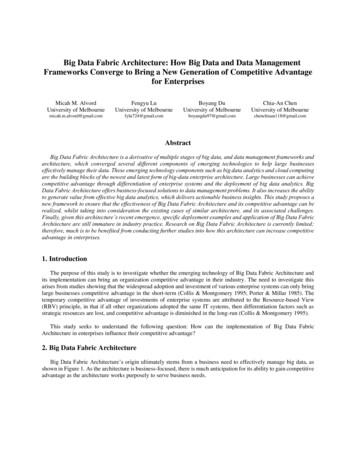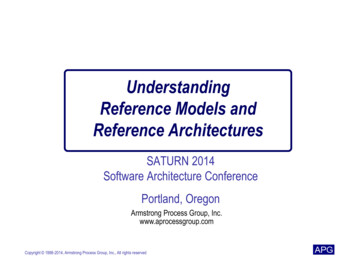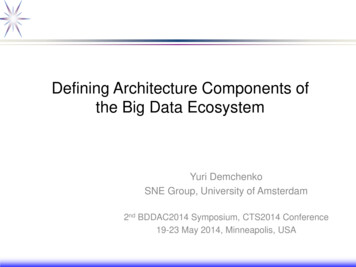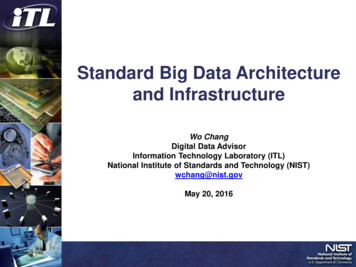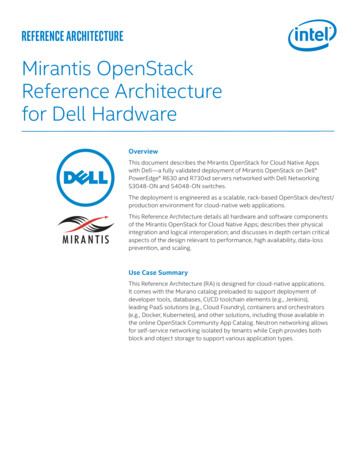
Transcription
2016 2nd International Workshop on BIG Data Software EngineeringA Reference Architecture for Big Data Systems in theNational Security DomainJohn KleinRoss Buglak, David Blockow, Troy Wuttke,Brenton CooperSoftware Engineering InstituteCarnegie Mellon UniversityPittsburgh, PA, USAData to Decisions Cooperative Research CentreKent Town, SA, Australiajklein@sei.cmu.edu{ross.buglak, david.blockow, cquirers, system builders, and other stakeholders of big datasystems need to define requirements, develop and evaluatesolutions, and integrate systems together. A reference architectureenables these software engineering activities by standardizingnomenclature, defining key solution elements and theirrelationships, collecting relevant solution patterns, and classifyingexisting technologies. Within the national security domain,existing reference architectures for big data systems have not beenuseful because they are too general or are not vendor-neutral. Wepresent a reference architecture for big data systems that isfocused on addressing typical national defence requirements andthat is vendor-neutral, and we demonstrate how to use thisreference architecture to define solutions in one mission area. Stakeholders who specify, evaluate, and acquire these big datasystems often lack software engineering technical expertise in thisemerging and dynamic technology space [2]. While thesestakeholders may have competence in other types of softwaresystems, the principles and practices for big data systems aredifferent, and general software knowledge may not be sufficient toensure success [3].A reference architecture (RA) serves as a mechanism to representand transfer software engineering knowledge that bridges from theproblem domain to a family of solutions. A RA defines domainconcepts and relevant qualities, decomposes the solution andcreates a lexicon to enable efficient communication, and providesguidance and principles for system stakeholders [4].CCS Concepts Informationsystems Dataanalytics Informationsystems Onlineanalyticalprocessing Informationsystems Information retrieval Information systems Datamanagement systems Information systems Spatial-temporalsystems Softwareanditsengineering Softwareinfrastructure Software and its engineering Distributedsystems organizing principlesThere are a number of published RAs for big data systems.However, these were not useful for our clients in the nationalsecurity domain, because they were too general (e.g., [5], [6], or[7]) or because the solutions were specific to a particular vendor’stechnology (e.g., [8]). We discuss these in more detail in theRelated Work section below.KeywordsReference architecture; big dataThe contribution of this paper is a big data RA for applications inthe national security domain, which includes:1. INTRODUCTIONThe national security application domain includes softwaresystems used by government organisations such as police at thelocal, state, and federal level; military; and intelligence. Big datasystems are pervasive in this domain, with applications rangingfrom: features on the ground, to support tactical, operational andstrategic intelligence analysis and planning.Network graph analysis to help police identify associates andorganisational affiliations. Predictive maintenance of aircraft, ships, and vehicles,combining measured data collected on the platform withmeteorological data, equipment supplier data, and othersources to optimise maintenance schedules (e.g., [1]).Geospatial analytics that identify movement and changes ofMotivating use cases;Architecture decomposition based on grouping of relatedconcerns into architectural modules;Mapping of current technologies onto the concerns;Demonstration of how to use the RA to create big datasystem architectures.Each of these topics is discussed in a subsequent section of thepaper.2. RELATED WORKRAs are a powerful software engineering knowledge transitiontool, capturing both domain and solution knowledge for aportfolio of related systems [9]. In their survey of the state of thepractice, Cloutier, et al. note that RAs facilitate multi-site, multiorganisation, and multi-vendor systems, which are all primaryconsiderations in our application domain.Permission to make digital or hard copies of all or part of this work forpersonal or classroom use is granted without fee provided that copies arenot made or distributed for profit or commercial advantage and that copiesbear this notice and the full citation on the first page. Copyrights forcomponents of this work owned by others than ACM must be honored.Abstracting with credit is permitted. To copy otherwise, or republish, topost on servers or to redistribute to lists, requires prior specific permissionand/or a fee. Request permissions from Permissions@acm.org.BIGDSE'16, May 16 2016, Austin, TX, USA 2016 ACM. ISBN 978-1-4503-4152-3/16/05 15.00DOI: http://dx.doi.org/10.1145/2896825.2896834There are a number of existing big data RAs. The US NationalInstitute of Standards and Technology (NIST) shepherded acommunity of researchers and practitioners to create a 7-volumeBig Data Interoperability Framework, which includes a Reference51
Architecture volume [10]. The NIST framework reflects thecontributions of more than 35 authors, and included public reviewand comments, producing an architecture that is broad in coverageand applicability, but uneven in depth and detail. The RApresented below bears some superficial similarities to the NISTframework, but is distinguished by several key differences:3.While both architectures are decomposed into elements withsimilar names, the decomposition rationale and principles arenever articulated in the NIST architecture and so an architectcannot easily allocate functions and qualities to elements ofthat architecture. Our architecture is organised using explicitprinciples, discussed below, allowing architects to easilyallocate new functions and qualities.Our RA draws a clear system boundary, with data producersand consumers outside of the scope of the system. The NISTarchitecture includes data producers and consumers insidethe RA, which leaves the scope effectively unbounded.The NIST RA is domain-agnostic. As such, it does notsatisfy the first key principle of that Cloutier, et al. identifyfor a reference, architecture, namely that of elaboratingmission, vision, and strategy [9]. The NIST RA represents a“Meta RA”, which must be further refined for an applicationdomain. Our RA could be viewed as one such refinement.4. Open Source Intelligence – This mission capability is usedfor decision support. Use cases include collecting and storingopen source data, such as web sites, social media (includingtext, audio, and video), identifying entities (people,organisations) and relationships to populate a knowledgegraph, querying the knowledge graph, and using theknowledge graph to summarise information about entities.Signals Intelligence Analysis – use cases in this mission areawere to capture and store electronic transmissions, and toexecute analytics to match new captures to archivedtransmissions.These use cases were analysed to identify requirements categoriesand general requirements relevant to big data, in areas such asdata types (e.g., unstructured text, geospatial, audio), datatransformations (e.g., clustering, correlation), queries (e.g., graphtraversal, geospatial), visualisations (e.g., image and overlay,network), and deployment topologies (e.g., sensor-localprocessing, private cloud, and mobile clients).4. REFERENCE ARCHITECTURE4.1 Organisation of the ReferenceArchitectureThe RA metamodel is shown in Figure 1. The architecture is acollection of modules, which decompose the solution intoelements that realise functions or capabilities, and that address acohesive set of concerns. Concerns are addressed by solutionpatterns, or by strategies, which are design approaches that areless prescriptive than solution patterns. Together, modules andconcerns define a solution domain lexicon, and the discussion ofeach concern relates problem space terminology (origin of theconcern) to the solution terminology (patterns and strategies).The strengths of the NIST RA include strict vendor neutrality, astand-alone volume providing clear definitions of big dataterminology, and a comprehensive inventory of use cases acrossmany domains (although the relationship of the RA to those usecases is not part of the baseline release).Technology vendors such as IBM [6], Oracle [7], and Microsoft[8] have produced big data RAs. Like the NIST RA, these RAsare not domain-specific, and while there are some domain-specificrefinements presented, none of those refinements reflects thenational security application domain.By structuring the problem and solution domains, RAscomplement other architecture knowledge sharing approaches.For example, knowledge bases can provide more detailedguidance for architects in specific areas of a RA, such asQuABaseBD that focuses on the Storage module concerns andtechnologies in this RA [9].3. DOMAIN REQUIREMENTS AND USECASESFigure 1 – Reference Architecture ConceptsThe domain-specific requirements for this RA were discovered byanalysing use cases in four mission capability areas. The missioncapability areas were selected to cover a broad set of functions,deployment topologies, and data processing capabilities.The concerns are multi-faceted. Some concerns capture externalconstraints on the system (e.g., type of workload), designdecisions (e.g., optimisations), or system quality attributes (e.g.,latency and ease of programming). This type of concern has asignificant impact on the design, analysis, or evaluation of amodule.The mission segments and uses cases analysed were:1.2.Strategic Geospatial Analysis and Visualisation – here weassessed map production from satellite imagery, whichincludes displaying the image with overlays showing knownfeatures, such as roads and buildings, and identifying andannotating new and changed features (i.e. adding metadata).This mission segment also included a use case that searchedmap data/metadata and rendered the results.Full-motion video analysis – this capability is used inmissions ranging from search-and-rescue to surveillancefrom fixed or mobile cameras. The use cases here were toacquire, render, and store a digital video stream, and to detectand track objects of interest.A second type of concern was related to reuse or sharing ofmodules. These concerns included differences in executiontriggers/rates (e.g., driven by input data streams, user requests, orfixed period) and whether the functions or capabilities providedby a module were typically shared within or external to the bigdata system.Other concerns align with stakeholder communities of interest orstakeholders roles, such as processing algorithms or systemmanagement. This type of concern helps stakeholders orient theirperspective on the RA by identifying the modules eachstakeholder needs to focus on.52
The last type of concern represents de facto partitioning of thecommercial and open source packages and frameworks used torealise big data solutions. Reflecting this partitioning in themodule decomposition simplifies the mapping between off-theshelf technology and the RA and helps stakeholders positionvendors and products within the RA.4.2.1.3 Preparation ModuleThis RA is intended to supplement other sources of generalarchitecture knowledge: The scope of the concerns identified inthe RA was limited to issues that arise from the volume, variety,and velocity of data in big data systems, and the solution patternsand strategies are focused on addressing these concerns in the bigdata context of high scale and heterogeneity. For example,usability is obviously a concern in any human-computer interface,and so this was not specifically identified as a concern in the RA.However, in a big data system, providing an indication of dataconfidence (e.g., from a statistical estimate, provenance metadata,or heuristics) in the user interface impacts usability, and this wasidentified as a concern for the Visualisation module. The concerndriven decomposition discussed below reflects this scoping. The main concern of the Preparation module is transforming datato make it useful for the other downstream modules, in particularAnalytics. Preparation performs the transformation portion of thetraditional Extract, Transform Load (ETL) cycle, including taskssuch as:Data validation (e.g. checksum validation);Cleansing (e.g. removing or correcting bad records);Optimisation (e.g. de-duplication);Schema transformation and standardization;Indexing to support fast lookup.The Preparation module may perform basic enrichment, whichadds information from other sources to a data record. Theenrichment process begins in Preparation and continues inAnalytics. The enrichment preformed in Preparation is usuallyvery simple processing, such as creating record counts forparticular types or categories, or performing a lookup to addlocation name based on latitude and longitude values. Later, theAnalytics module may perform more sophisticated enrichment,for example, using a recommendation engine to create newassociations to other records.4.2 Module DecompositionFigure 2 shows the system boundary and module decompositionof the RA. The RA assumes a system of systems context [10],where Data Providers and Data Consumers are external systemsthat are not under the same design or operational authority as thebig data system. These systems may be instances of big datasystems developed using this RA (or another architecture).4.2.1.4 Analytics ModuleThe Analytics module is concerned with efficiently extractingknowledge from the data, typically often working with multipledata sets with different data characteristics. Analytics cancontribute further to the transform stage of the ETL cycle byperforming more advanced transformations and enrichments tosupport knowledge extraction.The 13 modules are grouped into three categories: The Big DataApplication Provider includes application-level business logic,data transformations and analysis, and functionality to beexecuted by the system. The Big Data Framework Providerincludes the software middleware, storage, and computingplatforms and networks used by the Big Data ApplicationProvider. As shown in the figure, the system may include multipleinstances of the Big Data Application Provider, all sharing thesame instance of the Big Data Framework Provider.4.2.1.5 Visualisation ModuleThe Visualisation module is concerned with presenting processeddata and the outputs of analytics to a human Data Consumer, in aformat that communicates meaning and knowledge. It provides a"human interface" to the big data. Data Consumers are external tothe big data system.The third module category is Cross-Cutting Modules. Each of thethree Cross-Cutting modules addresses a set of concerns thatimpact nearly every module in the other two categories.Some visualisation techniques may involve producing a staticdocument, cached for later access (e.g. a text report or graphic),however other techniques often include on-demand generation ofan interactive interface (e.g. navigating and filtering searchresults, or traversing a social graph). Display of data confidenceand/or data provenance information is common for machinegenerated data, and the interactive visualisations may include theability to create, confirm, or correct (i.e. update) data.The following subsections discuss the modules in each of thethree categories.4.2.1 Big Data Application Provider Modules4.2.1.1 Application Orchestration Module4.2.1.6 Access ModuleApplication Orchestration configures and combines other modulesof the big data Application Provider, integrating activities into acohesive application. An application is the end-to-end dataprocessing through the system to satisfy one or more use cases.The Access module is concerned with the interactions withexternal actors, such as the Data Consumer, or with human users,via Visualisation. Unlike Visualisation, which addresses "humaninterfaces", the Access module is concerned with "machineinterfaces" (e.g. APIs or web services). The Access module is theintermediary between the external world and the big data systemto enforce security or provide load balancing capability.Orchestration may be performed by humans, software, or somecombination of the two, and may be fixed at system design timeor configurable via a Graphical User Interface (GUI) or DomainSpecific Language (DSL).Similar to the Collection module, the primary concern of theAccess module is matching the characteristics of the externalsystems. The format and style of the interfaces to systems willvary, and data may be pulled or pushed by the Access module.4.2.1.2 Collection ModuleThe Collection module is primarily concerned with the interfaceto external Data Providers. The Collection module is concernedwith matching the characteristics and constraints of the providersand avoiding data loss.53
Figure 2 – Module Decomposition of the Reference Architecture4.2.2 Big Data Framework Provider Modules4.2.2.3 Data Storage ModuleThe primary concerns of the Data Storage module are providingreliable and efficient access to the persistent data. This includesthe logical data organisation, data distribution and accessmethods, and data discovery (using e.g. metadata services,registries and indexes).4.2.2.1 Processing ModuleThe Processing module is concerned with efficient, scalable, andreliable execution of analytics. It provides the necessaryinfrastructure to support execution distributed across 10s to 1000sof nodes, defining how the computation and processing isperformed.The data organisation and access methods are concerned with thedata storage format (e.g. flat files, relational data,structured/unstructured data) and the type of access required bythe big data Application Provider (e.g. file-type API, SQL, graphquery). It is common for the Data Storage module to provide morethan one representation of a single data record (a type of denormalisation) to support efficient analytic execution for differentuse cases.A common solution pattern to achieve scalability and efficiency isto distribute the processing logic and execute it locally on thesame nodes where data is stored, transferring only the results ofprocessing over the network. The large number of processingnodes and the long execution duration of some analytic processeslead to concerns about process or node failure during execution.Another critical concern of the Processing module is the ability torecover and not lose data in the event of a process or node failurewithin the framework.When data is distributed across a cluster, the Data Storage modulewill be concerned with the availability and consistency of thedata, and the tolerance of partitions (network or node faults)within the cluster.4.2.2.2 Messaging ModuleThe Messaging module is concerned with reliable queuing,transmission, and delivery of data and control functions betweencomponents. While messaging is common in traditional ITsystems, its use in big data systems creates additional challenges.4.2.2.4 Infrastructure ModuleThe Infrastructure module provides the infrastructure resourcesnecessary to host and execute the activities of the other BDRAmodules. This includes:Big data solutions are often comprised of many different productsand frameworks, making integration a primary concern. TheMessaging module must support a variety of clients, programminglanguages, and enterprise integration patterns. The volume and throughput of messages in big data solutions is aparticular concern, and can necessitate distributed messagingframeworks. Volume also leads to concerns if durability (i.e.permanently storing all transferred messages) is needed. 54Networking: resources that transfer data from oneinfrastructure framework component to another;Computing: physical processors and memory that executesoftware;Storage: resources which provide persistence of the data;Environmental: physical resources (e.g. power, cooling) thatmust be accounted for when establishing an instance of a bigdata system.
Infrastructure and data centre design are concerns whenarchitecting a big data solution, and can be an important factor inachieving desired performance. Big data infrastructure needs to bescalable, reliable and support target workloads. 4.2.3 Cross-Cutting Modules4.2.3.1 Security ModuleSecurity concerns affect all modules of the RA. The Securitymodule is concerned with controlling access to data andapplications, including enforcement of access rules and restrictingaccess based on classification or need-to-know. Security is also concerned with intrusion detection andprevention. Big data systems can include introspective analyticsthat look at internal data and access patterns to perform intrusiondetection. Big data can present an attractive target to attackers, and ingeneral, security and privacy have not been primary concerns inthe development of many big data technologies (e.g., see thesecurity survey in http://www.quabase.sei.cmu.edu). Consistentapplication of controls requires a holistic approach to security andprivacy as data traverses multiple components of the architecture.5. MAPPING CURRENT TECHNOLOGYBig data system architectures and implementations rely oncomposition of existing open source and commercial softwaretechnologies [3]. In the national security application domain, inparticular, acquirers evaluating and analysing proposed solutionsneed an understanding of which off-the-shelf technologies areappropriate (or not appropriate) to satisfy a function or qualitywithin the RA. Furthermore, most users of this RA already havebig data systems within their enterprise, and a technologymapping provides an easy first step to view those systems throughthe RA lens.4.2.3.2 Management ModuleConcerns for the cross-cutting Management module are groupedinto two broad categories: System Management, including activities such as monitoring,configuration, provisioning and control of infrastructure andapplications;Data Management, involving activities surrounding the datalifecycle of collection, preparation, analytics, visualisationand access.To satisfy these stakeholder needs, our RA provides a mapping ofcommercial and open source products to modules. This is a simpletabular mapping, where rows are products and columns aremodules in the RA. An “x” at an intersection indicates that theparticular product is an appropriate technology to use in themodule. Products were identified based on stakeholder’s currentbig data systems, and from proposals for new systems. There were35 products mapped to Big Data Application Provider modules,and 64 products mapped to Big Data Framework Providermodules.4.2.3.3 Federation ModuleThe Federation module is concerned with interoperation betweenfederated instances of the RA. These concerns are similar totypical system of systems (SoS) federation concerns [10],however existing SoS federation strategies may not support thescale of big data systems.4.2.3.4 Common ConcernsThis “module” collects a set of concerns that did not map cleanlyinto any of the other modules, and which are not related to eachother in any meaningful way, but should be considered in thearchitecture of a big data system. These other concerns are: prevent a system from providing the required level ofavailability.Data organisation is a common concern, particularly for highdata volume use cases, as the way that data is stored cansignificantly impact performance downstream in theprocessing pipeline. Data organisation design decisions can'tbe deferred, but must be made early, so that each stage in theprocessing pipeline stores data so the next stage can access itefficiently.Technology stack decisions, both hardware and software, aredriven by several interwoven considerations. In addition tofeatures, concerns include standardization within the system,maturity, ease of operation, vendor support, cost, and staffskills.Accreditation, which is a domain-specific concern andinvolves assessing the cybersecurity qualities of the system.Software accreditation can be challenging for big datasolutions due to the prevalence of open source products insolution architectures.This mapping is maintained in a separate volume of the RA, as itis the most dynamic content, and is the least normative andprescriptive content.6. USING THE RA TO DEFINE SYSTEMARCHITECTURESScalability - the ability to increase or decrease the processingand storage provided, in response to changes in demand. In aperfectly scalable system, the cost of the provided resourcesis linearly related to the demand (usually up to some resourcelimit). In systems that are less scalable, the cost of theprovided resources increases faster than the demand, or theresource limit may be unacceptably low. In big data systems,scalability is often dynamic or “elastic”, and the architectureenables the system to adjust at runtime to changes inworkload. Scalability needs to be considered at all layers of abig data architecture, from the data centre infrastructurethrough to the application layer.Availability - the ability for a system to remain operationalduring fault conditions such as network outages or hardwarefailures. Similar to scalability, a holistic approach needs to betake to designing for availability, as a single component canOur RA concludes with a volume that contains tutorialinformation showing stakeholders how to use the architecture tocreate concrete solution designs, including examples ofidentifying relevant concerns, making design decisions, andselecting appropriate strategies and design patterns.Although the RA modules are presented “input to output” and“top to bottom”, as described above in Section 4, the tutorialrecommends that stakeholders consider the modules in a differentorder at design time, which reflects a user-centric requirementsperspective and also reflects the main design decisiondependencies among the modules. The recommended design timeorder is shown in Figure 3. The recommended design processproduces an initial system architecture, which would typically berefined as the system is prototyped and developed.55
1.2.3.4.5.6.7.8.9.10.11.12.13.appearance). This machine learning-based pipeline is instantiatedas Step 3 of the architecture, shown in Figure 6.Visualisation - What information do the users need?Collection – What are the data sources and how to collect the data?Analytics - What information needs extracting from the data?Preparation - What transformations are needed prior to the analytics?Data Storage - How will the data be stored to support analytics,visualisations and access?Processing - How will analytics execute?Application Orchestration - Does the processing pipeline needorchestration?Access - What API access is required? How will the data be retrieved?Messaging - Is supporting messaging infrastructure required?Management - How will the application and infrastructure be managed?Security - What security controls are required?Federation - Does the solution need to operate within a federation?Infrastructure - What infrastructure is needed?Figure 3 – Design time ordering of RA modulesThe rest of this section describes how the RA is used to design asimple open-source intelligence (OSINT) system, that takes datafrom Twitter feeds (Tweets) and detects events (e.g., protests,riots, etc.), and then correlates detected events with data fromnews media websites. This description is highly abbreviated,touching on some of the important module refinements andskipping over many of the less interesting concerns.We begin with Visualisation concerns, and decide that the primaryvisualisation will display detected events on a map display, andallow filtering to a specified time range. This need for geospatialdisplay and processing leads to an initial architecture iterationshown in Figure 4.Figure 6 - OSINT Architecture – Twitter Event DetectionConcerns related to Preparation are primarily data cleansing andnormalisation, e.g., Tweet geo-tags are converted to Region IDs,emoticons are converted to text, and duplicate news pages will beremoved. Tweets will be processed through a stream pipeline, andnew pages through a batch pipeline.Figure 4 - OSINT Architecture – Step 1We next turn to Data Storage concerns. The primary Tweet accessby analytics is by region ID and time range, so we decide to shardby region ID. We see that we can simplify some of the analyticprocessing and training by denormalising our data, creating anhourly summary for each region that includes counts of Tweets,unique users, new users, flags for the intervals that containanomalies, and labelling data for training the anomaly detector.Similar reasoning is applied to define the storage structures for thenews page data.Next, we consider the Collection concerns. The Twitter data andweb page data is semi-structured, and consists of text and images.Based on the Twitter API limits, and a need to retain 3 years oflive data, we decide that HBase is a good candidate for storingcollected data. The result of these decisions is the second step ofthe architecture, shown in Figure 5.Processing concerns depend on the Analytics to be performed. Inthis case, we choose Hadoop for batch processing, and SparkStreaming for stream processing for both Preparation andAnalytics.Our Application Orchestration identifies continuously, hourly,daily, monthly, as shown in Figure 7. We decide to use ApacheOozie as the workflow manager, because it fits well with theprocessing ecosystem that we have chosen earlier.Access concerns show that a thin browser client is appropriate tooverlay events onto maps. A separate map server and event serverare instantiated, with the event server hiding the complexity of theSQL queries to the PostGIS database.Figure 5 - OSINT Architecture – Step 2Management concerns included logging, metrics collection, andh
big data system. These systems may be instances of big data systems developed using this RA (or another architecture). The 13 modules are grouped into three categories: The Big Data Application Provider includes application-level business logic, data
